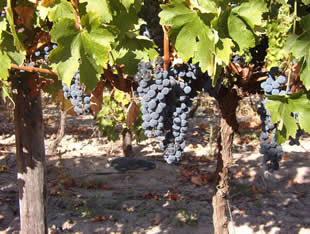|
South
African Shiraz
see
also: a more recent article on
South African Shiraz
 South Africa has traditionally made two styles of red wine.
First, Pinotage, its own grape variety, a cross of Cinsault and Pinot
Noir developed in the 1930s. Itís an unusual grape that has a loyal
following, but one that has always left me in two minds (you can read
my views on this variety here).
Second, we have the Bordeaux-style wines, Cabernet Sauvignon and
Merlot, and blends of the two. These can be very impressive.
Surprisingly, Shiraz (or Syrah, to use its French name) was until
recently quite rare. Perhaps this is because for a long time Cinsault
-- known in the Cape as Hermitage -- was wrongly thought to be Syrah
(hence the Ď-tageí in Pinotage). But South Africa has an ideal
climate for the highly marketable Syrah, and producers are now turning
to it in droves. Itís currently the third most planted red grape
after Pinotage and Cabernet Sauvignon. South Africa has traditionally made two styles of red wine.
First, Pinotage, its own grape variety, a cross of Cinsault and Pinot
Noir developed in the 1930s. Itís an unusual grape that has a loyal
following, but one that has always left me in two minds (you can read
my views on this variety here).
Second, we have the Bordeaux-style wines, Cabernet Sauvignon and
Merlot, and blends of the two. These can be very impressive.
Surprisingly, Shiraz (or Syrah, to use its French name) was until
recently quite rare. Perhaps this is because for a long time Cinsault
-- known in the Cape as Hermitage -- was wrongly thought to be Syrah
(hence the Ď-tageí in Pinotage). But South Africa has an ideal
climate for the highly marketable Syrah, and producers are now turning
to it in droves. Itís currently the third most planted red grape
after Pinotage and Cabernet Sauvignon.
This group of eight wines is too small to draw any meaningful
conclusions from, but solidly impressive performance does suggest that
South African producers are getting the hand of Shiraz.
Graham Beck Shiraz 2000, Robertson
Quite deep coloured. Attractive savoury nose with complex herby
and oaky notes combining well. The palate is accessible with ripe
fruit and fine-grained tannins plus spicy oak. Good concentration. A
nice commercial wine. Very good+ (£6.99 Asda)
Graham Beck The Ridge Shiraz 2000
Great density here. The nose shows tight berry fruit and oak
influence. Chunky, spicy palate with quite a bit of oak. The firm
tannins make this quite a structured wine, and one that I suspect will
need some time to show its best. Very good/excellent (£9.99 Waitrose)
Havana Hills Du Plessis Reserve Shiraz 1999, Tygerberg
Very rich modern nose displays exotic, spicy oak and opulent
liquoricey fruit, together with some vanilla sweetness. Chunky, oaky
palate shows a good concentration of berry fruit. Perhaps a little too
oaky, but great concentration. Very good+
Neil Ellis Vineyard Selection Shiraz 1999, Stellenbosch
Quite a classy nose, which displays tight berry fruit with a
spicy, cedary edge. Very refined. The palate is delicious, showing
tight-knit berry fruit with a spicy edge. Balanced, and in a slightly
more traditional style than some. Very good/excellent
Spice Route Flagship Syrah 1999, Paarl
Forward, attractive nose displays sweet herby fruit and a creamy,
spicy edge from the oak. The palate is concentrated and very modern
with an attractive herby edge. Good concentration, but itís very
much in the Ďinternationalí mould, which seems to be this
producerís house style. Very good+ (£11.50 Wine Society)
Delheim
Shiraz 1999, Stellenbosch, South Africa
Lots of character here. A deep coloured wine, with a pronounced meaty,
stinky and heb-tinged nose. The palate is powerful and savoury, with
herby, olive-laced fruit and a slight medicinal edge. Good tannin and
acidity. Tastes like a burly Crozes Hermitage with a tiny bit of
unripeness on the finish. A striking, impressive wine, but not to
everyone's taste. Very good+ (£7.99 Wine Rack)
Stellenzicht Shiraz 1998, Stellenbosch
No, not the Syrah, which is a different wine from the same
producer and sells for more than double the price of this one. Dark
berry fruit on the nose with a slightly oaky edge. The palate shows
modern juicy berry fruit. Quite dense and with good acidity, this is a
nice commercial wine. Very good+
Stellenzicht Syrah 1998, Stellenbosch
This is Stellenzichtís Syrah that has become famous, principally
for once beating Penfolds Grange in a high-profile blind tasting. It
has a deep coloured, rich, ripe, lush nose with a spicy, roasted edge.
The palate is savoury with great concentration but a slight green
olive/vegetal edge that spoils things a bit. Very modern styled wine:
quite attractive, but the vegetal hint is a slight let down. Very
good+ (c. £25 where available) 11/01
wines tasted July
2002; article published August 2002
|

